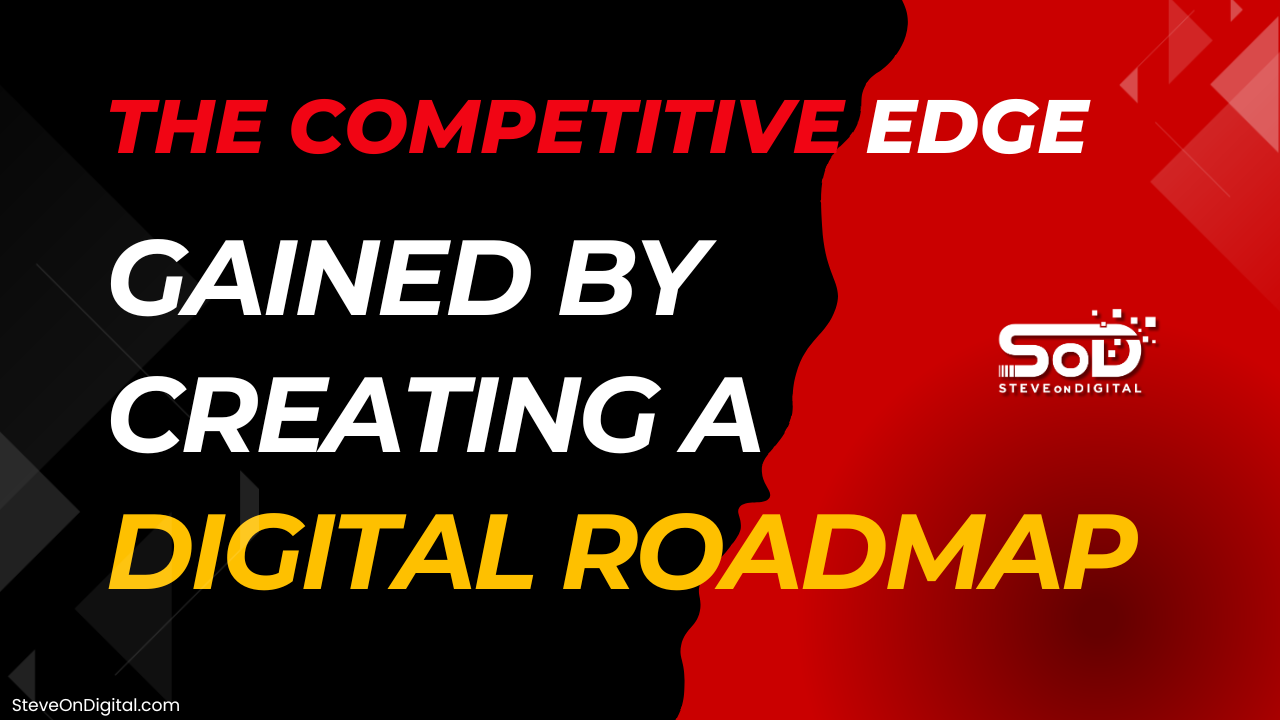Creating a digital roadmap offers significant benefits for businesses today. It provides a strategic plan for implementing digital tools and technologies, ensuring alignment with business goals. A well-structured digital roadmap improves operational efficiency, enhances communication, and boosts technology adoption rates, making your business more competitive and efficient.
As a Digital Transformation Specialist, I bring extensive expertise tailored for small and medium-sized businesses (SMEs). With a background in electrical engineering, an MBA, and a master’s in Project Management, I aim to help 1,000,000 business owners navigate the digital landscape. My experiences and practical insights from real-life scenarios are geared toward SMEs, reflecting my commitment to continuous learning and entrepreneurial support.
Understanding The Benefits Of Creating A Digital Roadmap
A comprehensive technology roadmap is a comprehensive plan that outlines how a business will implement digital tools and technologies. It’s crucial in the digital transformation process, guiding companies through various phases of adoption and integration.
Definition Of A Digital Roadmap
A digital transformation roadmap is a strategic plan that details how digital tools and technologies will be integrated into a business. This roadmap is vital for digital transformation, ensuring a structured approach to adopting new technologies.
- A digital transformation roadmap is a strategic plan that outlines how digital tools and technologies will be implemented.
- Strategic Vision: This defines the long-term goals and the desired outcome of the digital transformation.
- Implementation Plan: It includes the steps and actions needed to achieve the strategic vision.
- Timeline: A schedule that outlines when each phase of the implementation will take place.
Components Of A Digital Roadmap
The key components of a digital roadmap include ecosystem mapping and a detailed timeline. These elements help businesses visualize how various software and technologies interact and when they will be implemented.
- Key components include the software ecosystem and implementation timeline.
- Software Ecosystem: This shows how different software programs and tools will work together.
- Implementation Timeline: This timeline details when each technological solution will be introduced and in what order.
| Component | Description |
| Software Ecosystem | Shows how different software programs and tools work together. |
| Implementation Timeline | Details when each technological solution will be introduced and in what order. |
Key Benefits Of Creating A Digital Roadmap
A well-structured digital roadmap offers numerous benefits, helping businesses streamline operations, improve communication, and increase technology adoption rates.
Digital strategies empower companies to protect themselves from culture shifts and digital threats.
| Benefit | Description |
| Improved Operational Efficiency | Streamlines processes, reduces redundancies, and leads to time and cost savings. |
| Enhanced Communication | Facilitates better team communication and collaboration. |
| Higher Technology Adoption Rates | Engages employees in the planning stages, leading to a smoother transition to new technologies. |
Improved Operational Efficiency
A focused digital strategy helps companies identify digitalization opportunities and guides them on how to apply these to their current business models and offerings.
Digital roadmaps streamline business processes, making operations more efficient and reducing redundancies. This leads to significant time and cost savings.
- Streamlines operations for better efficiency.
- Streamlined Processes: Simplifies and optimizes workflows, enhancing productivity.
- Reduced Redundancies: Eliminates duplicate tasks, ensuring more efficient use of resources.
Enhanced Communication
A digital roadmap facilitates better communication within teams. It provides a clear visual representation of how and when new tools will be introduced, ensuring everyone is on the same page.
- Facilitates better team communication.
- Clear Communication Channels: Establishes straightforward channels for team interaction.
- Improved Team Collaboration: Encourages collaborative efforts by providing a shared understanding of the digital strategy.
Higher Technology Adoption Rates
Involving team members in the planning process increases the adoption rates of new technologies. When employees understand and contribute to the roadmap, they are more likely to embrace new tools.
- Increases technology adoption.
- Involved Team Members: Engages employees in the planning stages.
- Higher Adoption Rates: Leads to a smoother transition to new technologies.
Creating a digital roadmap isn’t just a plan; it’s a strategic move towards achieving digital success. From improving operational efficiency to enhancing communication and boosting technology adoption rates, the benefits are substantial.
As someone who has seen the transformative power of a well-executed digital roadmap, I can attest to its value in driving business growth and staying competitive in today’s digital landscape. An innovative digital strategy can further enhance these efforts by implementing new digital initiatives and technologies to unlock new opportunities and create competitive advantages.
The Role Of Digital Roadmaps In Digital Transformation
Aligning With Business Strategy
A digital roadmap aligns digital initiatives with overall business strategies. It’s not just about adopting new technologies; it’s about integrating them in a way that supports your business goals.
I’ve seen firsthand how a well-aligned digital roadmap can transform a business, making it more competitive and efficient.
- Aligns digital initiatives with business goals.
- Business Strategy Alignment: Ensures that all digital efforts support the broader business strategy.
- Goal Setting: Helps in defining clear, achievable goals that are aligned with the business vision.
Supporting Digital Transformation Journeys
Digital roadmaps support continuous digital transformation. They provide a structured approach that allows businesses to evolve with technology. This continuous improvement is key to staying competitive in today’s market.
- Supports continuous digital transformation.
- Continuous Improvement: Encourages ongoing development and adaptation.
- Long-term Vision: Provides a roadmap for sustained growth and innovation.
Steps To Create An Effective Digital Roadmap
| Step | Description |
| Assessing Current Digital Capabilities | Evaluate existing digital tools and technologies to understand current capabilities. |
| Identifying Business Objectives | Define clear business objectives that align with overall business goals. |
| Developing the Roadmap | Map out strategies and create an implementation plan. |
| Implementing the Roadmap | Execute the plan, monitor progress, and make necessary adjustments. |
Assessing Current Digital Capabilities
The first step in creating a digital roadmap is to assess your current digital capabilities. This involves evaluating existing digital tools and technologies to understand where you stand and what you need.
- Assess current digital capabilities.
- Current Tools Analysis: Review and analyze the digital tools currently in use.
- Capability Assessment: Determine the effectiveness and efficiency of these tools.
Identifying Business Objectives
Next, define clear business objectives that the digital roadmap will support. These objectives should be aligned with your overall business goals to ensure that the digital strategy drives business success.
- Identify and set business objectives.
- Define Objectives: Clearly articulate what you want to achieve.
- Align Objectives with Goals: Ensure that these objectives support your business goals.
Developing The Roadmap
Once you have a clear understanding of your current capabilities and objectives, it’s time to develop a successful digital transformation roadmap. This involves mapping out strategies and creating an implementation plan.
- Develop a comprehensive roadmap.
- Map Out Strategies: Outline the strategies needed to achieve your objectives.
- Create an Implementation Plan: Develop a detailed plan for implementing these strategies.
Implementing The Roadmap
The final step is to implement the digital roadmap. This involves executing the plan, monitoring progress, and making necessary adjustments.
- Implement the roadmap effectively.
- Execution: Carry out the planned actions.
- Monitoring and Adjustment: Continuously monitor progress and make adjustments as needed.
Tools And Technologies For Digital Roadmaps
| Tool/Technology | Description |
| Digital Adoption Platforms | Facilitates digital adoption and ensures employees are adequately trained. |
| Project Management Tools | Tools like Trello or Asana that help manage projects efficiently. |
| Collaboration Software | Tools like Slack or Microsoft Teams that enhance team collaboration. |
| Emerging Technologies | AI, Machine Learning, IoT, and Blockchain offer new opportunities for innovation and efficiency. |
Digital Adoption Platforms
Digital adoption platforms are crucial for facilitating digital transformation. They help businesses integrate new technologies smoothly and ensure that employees are adequately trained.
- Facilitates digital adoption.
- Adoption Tools: Tools that help in the adoption of new digital technologies.
- Training Resources: Resources to train employees on new technologies.
Software And Applications
There are several essential software applications that can support the creation and maintenance of a digital roadmap. These tools help in project management and team collaboration.
A well-defined technology strategy framework can provide a clear roadmap for technology initiatives, guiding investment decisions, and helping organizations deploy technology with a plan for the future.
- Essential software tools.
- Project Management Tools: Tools like Trello or Asana that help manage projects efficiently.
- Collaboration Software: Tools like Slack or Microsoft Teams that enhance team collaboration.
Emerging Technologies
Emerging technologies like AI, machine learning, IoT, and blockchain are transforming digital roadmaps. These technologies offer new opportunities for innovation and efficiency.
- Leveraging emerging technologies.
- AI and Machine Learning: Technologies that provide advanced analytics and automation.
- IoT and Blockchain: Technologies that enhance connectivity and security.
Challenges In Creating A Digital Roadmap
| Challenge | Description |
| Resistance to Change | Employees may feel threatened by new technologies or processes. |
| Budget Constraints | Allocating sufficient resources while maintaining cost-effectiveness. |
| Technological Gaps | Identifying and bridging gaps in current technology or expertise. |
Resistance To Change
One of the most common challenges when creating a digital roadmap is resistance to change. Employees may feel threatened by new technologies or processes, fearing that their roles will become redundant or more demanding. Addressing these concerns is crucial for a successful digital transformation.
- Overcome resistance to change.
- Employee Engagement: Involve employees in the planning process to make them feel valued and heard. This can significantly reduce resistance.
- Change Management Strategies: Implement structured change management strategies that include training and clear communication to ease the transition.
Budget Constraints
Budget constraints can also hinder the creation and implementation of a digital roadmap. Allocating sufficient resources while maintaining cost-effectiveness is a delicate balance.
- Handle budget constraints.
- Budget Planning: Carefully plan your budget by prioritizing initiatives that offer the highest return on investment.
- Cost-Effective Solutions: Look for cost-effective digital tools and technologies that provide the needed functionalities without breaking the bank.
Technological Gaps
Identifying and bridging technological gaps is another challenge. Many businesses lack the necessary technology or expertise to support their digital transformation efforts.
- Bridge technological gaps.
- Gap Analysis: Conduct a thorough gap analysis to identify where your current technology falls short.
- Skill Development: Invest in skill development and training programs to equip your team with the necessary knowledge and expertise.
Case Studies Of Successful Digital Roadmaps
Case Study 1: Adobe’s Transformation
Adobe’s digital transformation is a prime example of how a well-planned digital roadmap can lead to remarkable success. Adobe transitioned from a traditional software license model to a subscription-based model, revolutionizing its business operations.
- The success story of Adobe’s transformation.
- Strategic Initiatives: Adobe implemented strategic initiatives such as the Creative Cloud, which integrated all its software into a single subscription service.
- Outcomes Achieved: This shift not only increased Adobe’s revenue but also improved customer satisfaction and engagement.
Case Study 2: Netflix’s Digital Strategy
Netflix’s digital strategy has been pivotal in its growth from a DVD rental service to a global streaming giant. Its digital roadmap focused on leveraging data analytics and AI to enhance user experience and content recommendations.
Digital strategy research has played a crucial role in understanding the impact of technology on the business and categorizing digital strategies into attack and defend categories.
- Netflix’s digital success.
- Strategy Implementation: Netflix implemented a data-driven strategy that personalized user experiences and optimized content delivery.
- Achieved Benefits: This approach resulted in increased subscriber retention, higher user engagement, and a significant competitive advantage in the streaming market.
Best Practices For Maintaining A Digital Roadmap
Regular Updates
Regularly updating the digital roadmap is essential to keep it relevant and aligned with business goals. Technology and business needs evolve, and so should your roadmap.
- Ensure regular updates.
- Scheduled Reviews: Schedule regular reviews to assess the progress and make necessary adjustments.
- Feedback Integration: Incorporate feedback from stakeholders and team members to refine the roadmap.
Continuous Monitoring
Continuous monitoring of the digital roadmap ensures that the implementation stays on track and any issues are promptly addressed.
- Continuous monitoring techniques.
- Performance Metrics: Use performance metrics to track the effectiveness of the digital initiatives.
- KPI Tracking: Monitor key performance indicators (KPIs) to ensure that the digital transformation goals are being met.
Involving Stakeholders
Engaging stakeholders throughout the process is crucial for the success of the digital roadmap. Their input and support can drive the initiatives forward.
- Stakeholder involvement strategies.
- Regular Meetings: Hold regular meetings with stakeholders to discuss progress and gather their insights.
- Transparent Communication: Maintain transparent communication to keep everyone informed and aligned with the roadmap objectives.
Future Trends In Digital Roadmaps
AI And Machine Learning Integration
AI and machine learning are becoming increasingly integral to digital roadmaps. These technologies can drive predictive analytics and smart automation, enhancing the overall digital strategy.
- AI-driven digital roadmaps.
- Predictive Analytics: Use AI to analyze data and predict future trends, enabling better decision-making.
- Smart Automation: Implement machine learning algorithms to automate repetitive tasks and improve efficiency.
Increased Focus On Cybersecurity
With the rise of digital transformation, cybersecurity has become more critical than ever. Ensuring that digital roadmaps incorporate robust security measures is essential to protect business operations.
- Cybersecurity considerations.
- Security Protocols: Establish and enforce strict security protocols to safeguard data and systems.
- Risk Management: Implement comprehensive risk management strategies to mitigate potential threats.
Evolution Of Digital Tools
Digital tools are continually evolving, offering new functionalities and integration capabilities. Staying updated with these advancements can significantly enhance the effectiveness of a digital roadmap.
- Evolution of digital tools.
- Tool Enhancements: Keep abreast of the latest enhancements in digital tools to leverage their full potential.
- Integration Capabilities: Ensure that new tools can seamlessly integrate with existing systems for a smooth transition.
Final Thoughts
Recap Of Key Benefits
Creating a digital roadmap offers numerous benefits, including improved operational efficiency, enhanced communication, and higher technology adoption rates. It aligns digital initiatives with business goals and supports continuous improvement.
- Key benefits recap.
- Operational Efficiency: Streamlines processes and reduces redundancies.
- Enhanced Communication: Facilitates better team collaboration and communication.
Encouragement To Start Planning
If you haven’t started developing your digital roadmap, now is the time. Take the first step towards achieving digital success by planning and implementing a comprehensive digital strategy.
- Start planning your digital roadmap.
- Take the First Step: Begin by assessing your current digital capabilities and identifying your business objectives.
- Achieve Digital Success: With a well-structured digital roadmap, you can navigate the digital landscape successfully and stay competitive.





